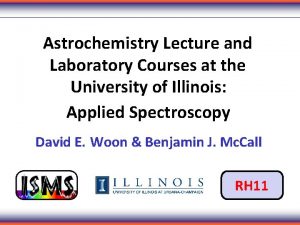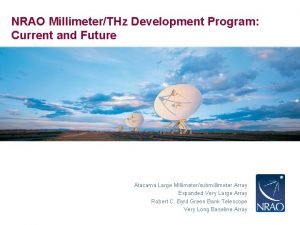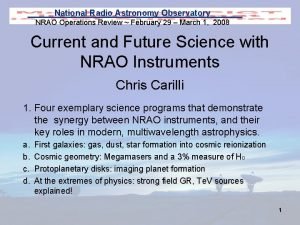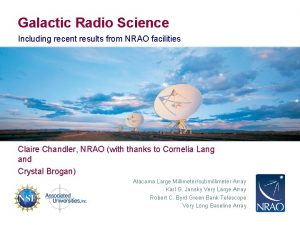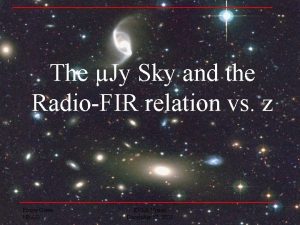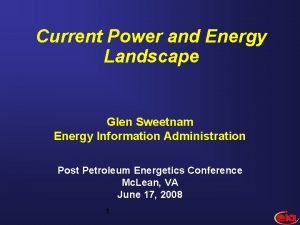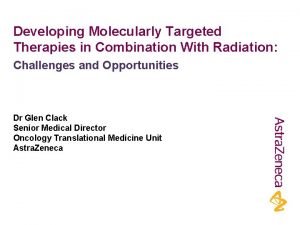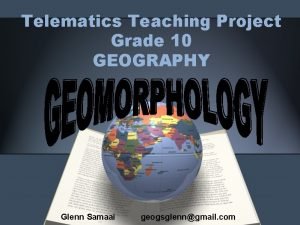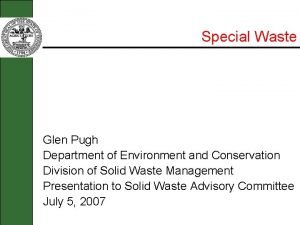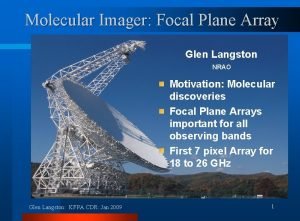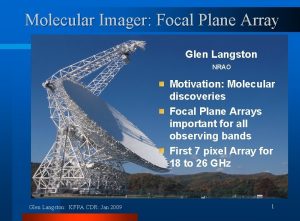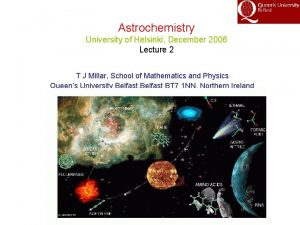Improved Tools for Astrochemistry Glen Langston NRAO Methods













- Slides: 13

Improved Tools for Astrochemistry Glen Langston NRAO Methods for detection of families of molecules Example: HC 7 N collaboration with Barry Turner Wide-band Spectrometers Focal Plane Arrays Glen Langston: OSU 08 1

Molecular Discoveries: 100 m World’s most sensitive Telescope in frequency range 10 to 50 GHz Discovered >7 new interstellar molecules, including propenal and propanal Widely distributed, not exclusively in compact cores Glen Langston: OSU 08 Hollis, Snyder, Remijan and Jewell 2004 -2008 2

HC 7 N HC 9 N HC 11 N and HC 13 N Large Cyanopolyynes known to be abundant in TMC-1 Glen Langston: OSU 08 3

HC 9 N, HC 11 N and HC 13 N Straight forward lesson: Larger molecules exhibit more lines at lower frequencies than their simpler counterparts. Wide bandwidth spectrometers needed with full frequency coverage at high spectral resolution. Improved spectrometer is a priority for NRAO Glen Langston: OSU 08 4

Updated HC 13 N Models for HC 13 N moments of inertia and Taurus cloud temperature (9 Kelvin's) show peak of emission at 12 to 15 GHz Prediction common to all ‘large’ molecules in cold clouds: Many lines at lower frequencies (< 20 GHz) Spacing between HC 11 N lines 338 MHz Spacing between HC 13 N lines 214 MHz (17 lines in 3. 6 GHz) Intensity (Kelvin) Model of HC 13 N line strength for Taurus Molecular Cloud Frequency (MHz) Glen Langston: OSU 08 5

Selections of HC 13 N observations HC 13 N Lines are separated by 214 MHz Simultaneous four 50 MHz bandwidth observations Glen Langston: OSU 08 6

Daily System Check Daily system check observations: Two 4 minute observations. Simultaneous four 50 MHz bandwidth Widely separated (Delta nu > 1 GHz) Glen Langston: OSU 08 7

HC 7 N and HC 9 N We concentrated on larger HCn. N molecules with fourth band. Glen Langston: OSU 08 8

HC 7 N Isotopomers In the HC 13 N observations, a family of 13 C Isotopomers is detected Ratio of HC 7 N and Isotopomers Abundance = 87: 1 Langston and Turner (2007), Ap. J. 658, 455 Glen Langston: OSU 08 9

K-band Focal Plane Array Specification Requirement Frequency Band 18 -26. 5 GHz (complete KBand coverage) Instantaneous RF Bandwidth 1. 8 GHz Number of beams 7 (expandable up to 61) TRX (each beam, not including sky) < 25 K (75% of band)* < 35 K (entire band) Aperture Efficiency >55%, any pixel Polarization dual, circular (axial ratio <= 1 d. B) Polarization Isolation >25 d. B Pixel-Pixel Isolation >30 d. B Headroom > 30 d. B (to 1 d. B compression point) Glen Langston: OSU 08 10

Design Configuration High performance multi-pixel is technically challenging Single Pixel Glen Langston: OSU 08 Seven Pixel 11

Mapping Large Regions Glen Langston: OSU 08 12

Future Directions Lower frequency (6 to 26 GHz) observations are critical for study of important large molecules. Demonstrated detection of a class of molecules by simultaneous observation of weak lines. Isotopomers are a significant fraction for large molecules (7/50 ~ 1/7 for HC 7 N) Studies of Astro-chemistry will be advanced by: Increasing spectrometer bandwidth Increasing number of beams in receivers Software for optimum “folded” searches of multiple lines in large molecules Glen Langston: OSU 08 13
